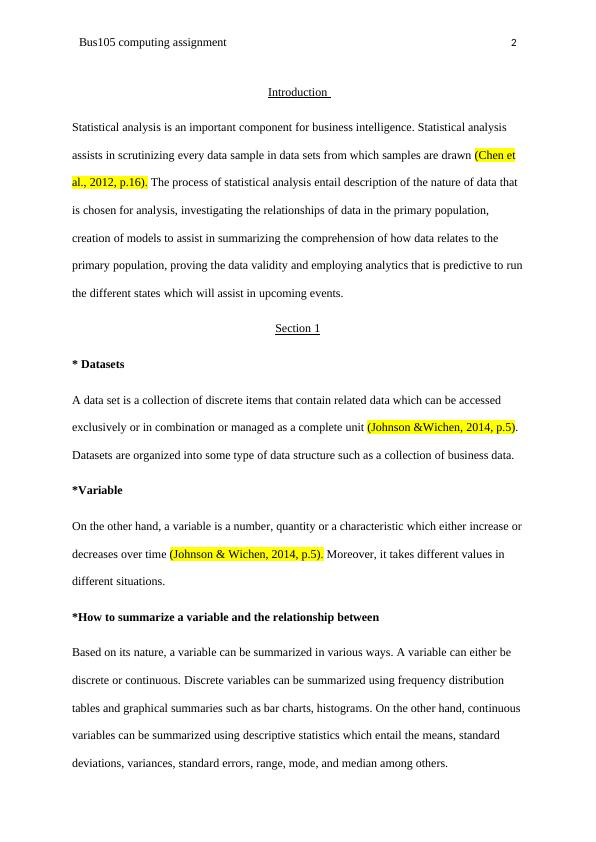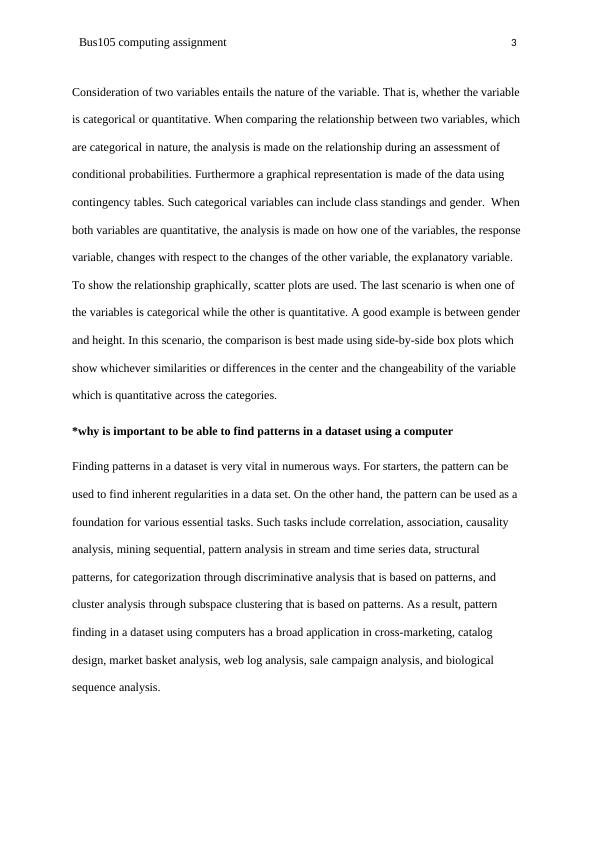BUS105 - Computing Assignment
16 Pages2113 Words29 Views
Added on 2020-05-16
BUS105 - Computing Assignment
Added on 2020-05-16
ShareRelated Documents
RUNNING HEADER: Bus105 computing assignment1Bus105 computing assignmentName:Aanchal ANEJAStudent number:11600869Allocated sample: 107

Bus105 computing assignment2Introduction Statistical analysis is an important component for business intelligence. Statistical analysis assists in scrutinizing every data sample in data sets from which samples are drawn (Chen et al., 2012, p.16). The process of statistical analysis entail description of the nature of data that is chosen for analysis, investigating the relationships of data in the primary population, creation of models to assist in summarizing the comprehension of how data relates to the primary population, proving the data validity and employing analytics that is predictive to runthe different states which will assist in upcoming events.Section 1* DatasetsA data set is a collection of discrete items that contain related data which can be accessed exclusively or in combination or managed as a complete unit (Johnson &Wichen, 2014, p.5). Datasets are organized into some type of data structure such as a collection of business data. *VariableOn the other hand, a variable is a number, quantity or a characteristic which either increase ordecreases over time (Johnson & Wichen, 2014, p.5). Moreover, it takes different values in different situations.*How to summarize a variable and the relationship between Based on its nature, a variable can be summarized in various ways. A variable can either be discrete or continuous. Discrete variables can be summarized using frequency distribution tables and graphical summaries such as bar charts, histograms. On the other hand, continuousvariables can be summarized using descriptive statistics which entail the means, standard deviations, variances, standard errors, range, mode, and median among others.

Bus105 computing assignment3Consideration of two variables entails the nature of the variable. That is, whether the variable is categorical or quantitative. When comparing the relationship between two variables, which are categorical in nature, the analysis is made on the relationship during an assessment of conditional probabilities. Furthermore a graphical representation is made of the data using contingency tables. Such categorical variables can include class standings and gender. When both variables are quantitative, the analysis is made on how one of the variables, the responsevariable, changes with respect to the changes of the other variable, the explanatory variable. To show the relationship graphically, scatter plots are used. The last scenario is when one of the variables is categorical while the other is quantitative. A good example is between gender and height. In this scenario, the comparison is best made using side-by-side box plots which show whichever similarities or differences in the center and the changeability of the variable which is quantitative across the categories.*why is important to be able to find patterns in a dataset using a computerFinding patterns in a dataset is very vital in numerous ways. For starters, the pattern can be used to find inherent regularities in a data set. On the other hand, the pattern can be used as a foundation for various essential tasks. Such tasks include correlation, association, causality analysis, mining sequential, pattern analysis in stream and time series data, structural patterns, for categorization through discriminative analysis that is based on patterns, and cluster analysis through subspace clustering that is based on patterns. As a result, pattern finding in a dataset using computers has a broad application in cross-marketing, catalog design, market basket analysis, web log analysis, sale campaign analysis, and biological sequence analysis.

Bus105 computing assignment4Section 2a)Sample 10710,00020,00030,00040,00050,00060,000$8,000 $10,000 $12,000 $14,000 $16,000 $18,000 $20,000 $22,000 f(x) = − 0.16 x + 19253.06Distance travelled SellingpriceFigure 1: Sample 107 scatter plotFrom the figure 1 above, it can be seen that the base selling price of size 10 cars is $19,253.For every increase in distance traveled, the selling price of the size 10 cars decreasedwith 0.158 units all other factors held constant. Thus, there is a negative relationship between the selling price and the distance traveled.b)The predicted selling price when the distance travelled is 30,000km from the linear regression in part (a) is;Predicted selling price = -0.1585*30,000+19,253 = $14,498Thus, when a car travels 30,000 km, the selling price of the car will be $14,498.c)Z-score of estimate:The average of all the 10,000 estimates is 14000 with standard deviation 392.

End of preview
Want to access all the pages? Upload your documents or become a member.
Related Documents
BUS105 Business Statistic Computing Assignmentlg...
|13
|1555
|43
BUS105 Computing Assignment - Doclg...
|10
|1368
|88
Semester 1, 2018 BUS105 Computing Assignmentlg...
|13
|2177
|341
Comparing different types of variableslg...
|17
|1561
|466
Comparing different types of variables: a case studylg...
|15
|1238
|339
Introduction to Business Statisticslg...
|16
|1346
|100
